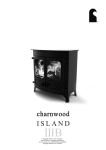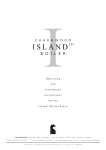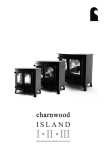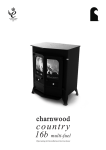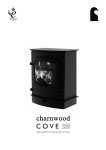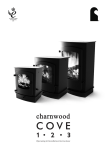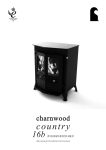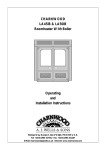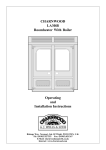Download Charnwood Island 3 Operating instructions
Transcript
® charnwood ISLAND IIIB Operating & Installation Instructions ISLAND IIIB CONTENTS O P E R AT I N G I N S T R U C T I O N S Fuel 4 Door Operation 4 Multi Grate 4 Lighting 4 Controlling The Fire 5 Riddling 5 Refuelling 5 Ash Clearance 5 Overnight Burning 6 Special Point when Burning Wood 6 Maintenance 6 Throat plate flueway cleaning 6 Chimney Sweeping 7 Trouble Shooting 7 If you need any Further Help 8 INSTALLATION INSTRUCTIONS Health & Safety Precautions 9 Specification 9 Chimney 9 Hearth & Fire Surround 9 Central Heating System 10 System Controls 11 Connection to Flues 12 Soot Doors 12 Thermostat 12 Pre Lighting Check 12 Commissioning 12 Dimensions 13 Parts Lists 14 Certification 15 Ref. Island IIIB 06.13 Issue E charnwood ISLAND OPERATING INSTRUCTIONS ® to close. The stove is normally run with the doors shut. Before lighting the stove check with the installer that the work and checks described in the Installation Instructions have been carried out MULTI GRATE correctly and that the chimney has been swept, is sound and free Your Charnwood Island is fitted with a multi grate to enable wood to from any obstructions. The stove is not suitable for use in a shared be burned and ash to be cleared. The grate has two positions: flue system. 1) In the open position the grate bars are vertical with gaps in Your Island stove has been designed to work with the minimum between allowing the primary combustion air to come up through effort. If any operation - such as riddling the grate or opening and the grate and through the fuel bed. closing the doors - begins to require extra force then the cause must be investigated and corrected to prevent damage being caused to the 2) In the closed position the grate bars are horizontal, allowing the stove. combustion air to come round the sides of the grate and over the top of it. When in the closed position ash is able to build up on the grate Remember that the stove will be hot and is made from hard materials as is necessary for effective wood burning. - ensure that you have a good balance before operating the fire. When using the stove in situations where children, aged and/or Fig. 1. Stove Controls infirm persons are present a fireguard must be used to prevent accidental contact with the stove. The fireguard should be manufactured in accordance with BS 8423:2002. Door Handle, Clockwise to Open Do not use an aerosol spray on or near the stove when it is alight. There is a risk of explosion or flash ignition of the spray. This stove is capable of intermittent or continuous operation. Grate Lever FUEL This stove is intended primarily for burning wood. Only dry well seasoned wood should be burnt on this appliance as burning wet unseasoned wood will give rise to heavy tar deposits in the stove, on Thermostat Control, Clockwise to Increase the glass and within the chimney. For the same reason hard woods (such as Ash, Beech and Oak) are better than soft woods (such as Pine and Spruce). Burning wet unseasoned wood will also result in Identification Plate, Pull Forward and Swing Down Movement of the grate from one position to the other is effected considerably reduced outputs. The wood should be cut and split and using the tool supplied as shown in Fig. 2. The grate is put into the then left to season in a well ventilated dry place for at least one year open position by moving the tool up until the handle is in the 1 but preferably two years before use. o'clock position. The grate is put into the closed position by moving PETROLEUM COKE IS NOT SUITABLE FOR USE ON THIS the tool down until the handle is in the 5 o'clock position. To riddle APPLIANCE. ITS USE WILL INVALIDATE THE GUARANTEE. the appliance the tool should be moved between the 1 o'clock and 3 For advice on other fuels please contact Charnwood. o'clock positions several times. When burning wood the ash should DOOR OPERATION or twice a week. be allowed to build up and riddling should only be carried out once The door handle has been carefully designed so that in normal use it may be operated using bare hands. However, if you need to open the LIGHTING doors when the fire is running at maximum then the use of a cloth or Light the Stove using dry kindling wood and paper or fire lighters. Set glove may be required. the grate into either the closed position or the open position as required. Place the paper, or fire lighters, and kindling on the grate Take care not to touch the doors as they will be hot when the fire is and cover with a few small dry logs. Open the thermostat control burning. Turn the door handle clockwise to open, and anti-clockwise fully (see Fig. 1). Light the paper or fire lighters. Close the doors until 4 charnwood ISLAND OPERATING INSTRUCTIONS ® Fig. 2. Multifuel Grate just one control to be used. The balance between primary and secondary air for particular flue conditions is pre-set using the sliding ion it os nP control mounted on the thermostat box beneath the stove. Once set e Op this should not need to be adjusted. Riddle For correct firing we recommend the use of a stove pipe thermometer which may be purchased from your supplier or from ourselves. Clo sed Po si RIDDLING tio n When burning wood, ash should be allowed to build up and only riddled when the ash begins to cover the slots in the rear fireplate. The fire should be riddled with the doors shut (see Fig. 2). Place the tool onto the riddling lever and rotate between the 1 o'clock and 3 the fuel is well ignited then load with fuel. Once the fire is up to o'clock positions several times. Too much riddling can result in temperature the airwash system will begin to work, so allow the fire emptying unburnt fuel into the ashpan and should therefore be to become hot before adjusting the thermostat to the required avoided. After riddling, the grate should be put back into the open or setting. closed position as required (the tool should be in the 1 o'clock On initial lighting, the stove may smoke and give off an odour as the position for open grate or in the 5 o'clock position for closed grate). silicon paint with which the firebox is painted reacts to the heat. This is normal and will cease after a short time, but meanwhile the room REFUELLING should be kept well ventilated. Keep the firebox well filled but do not overfill to prevent fuel from spilling over the top of the front fire bar. Logs should be evenly At first only light a small fire and burn it slowly for two hours to allow distributed, filling the firebed to give the most pleasing flame pattern. any residual moisture in the bricks to evaporate. Care should be taken, especially when burning wood, that fuel does When relighting the stove, riddle slightly and then empty the ashpan. not project over the front fire bar or damage to the glass may be CONTROLLING THE FIRE caused when the doors are closed. It can also cause the glass to blacken. Maximum filling height is such that logs cannot fall from the The fire is controlled by the water temperature thermostat. The fire when the doors are opened. Liquid fuels are not to be used on water temperature is set by the control knob shown in Fig. 1. Turn this appliance. the knob clockwise to increase the water temperature or anticlockwise to decrease. ASH CLEARANCE This thermostat controls both primary and secondary air, enabling The ashpan should be emptied regularly before it becomes too full. Never allow the ash to accumulate in the ashpan so that it comes in Fig. 3. Secondary air Adjustment contact with the underside of the grate as this will seriously damage the grate bars. The ashpan is handled using the tool provided. Care should be taken to ensure that ash is cool before emptying it into plastic liners or bins. Thermostat Knob To make ash removal easier there is a special Charnwood ash carrier available. This may be purchased from your supplier or, in case of Thermostat Box Increase Decrease Thermostat rod and connector difficulty, from ourselves. Wing nut Secondary air pre-set slide 5 charnwood ISLAND OPERATING INSTRUCTIONS ® OVERNIGHT BURNING running the fire at a fast rate for a few minutes. Do not use abrasive For overnight burning the fire doors must be closed. Use large logs cleaners or pads as these can scratch the surface which will weaken the glass and cause premature failure. Aerosol spray cleaners should rather than small ones. not be used near the appliance whilst it is under fire. If the fire is very low, it may be necessary to add a little fuel and turn the thermostat control up to maximum for a brief period until the When Not in Use fire is burning brightly, before filling with fuel. When the new fuel has If the fire is going to be out of use for a long period (for instance in ignited, the thermostat control should be turned down to the the summer) then to prevent condensation, and hence corrosion, the required setting. If the central heating pump is off overnight then the air control should be left fully open and the fire doors left ajar. It is thermostat may be left at the same setting for both day and night also advisable to sweep the chimney and clean out the fire. Spraying operation. If the central heating pump is on overnight, set the the inside of the doors and firebox with a light oil, such as WD40, thermostat control to give the required level of heating. Some will also help to keep all internal parts working well. experimentation will be necessary to find the settings most suitable After long periods where the fire has been out of use, the chimney for the particular fuel used and the draw on the chimney. and appliance flueways should be cleaned before lighting. To revive the fire, add some small logs and open the thermostat Door Seals control to maximum. When the fire is burning well load on more fuel For the fire to operate correctly it is important that the door seals as necessary and move the thermostat control to the desired setting. are in good condition. Check that they do not become worn or frayed and replace them when necessary. SPECIAL POINTS WHEN BURNING WOOD Servicing The grate should be kept in the closed position and should not be It is recommended that the fire is serviced once a year to keep it in riddled until the ash becomes so deep that it begins to block the first class working order. After cleaning out the firebox thoroughly, passage of air into the firebox at the sides or back of the grate. When check that all internal parts are in good working order, replacing any this is the case do not remove all of the ash using the riddling parts that are beginning to show signs of wear. Check that the doors mechanism but keep a layer about half an inch thick as this enables seals are in good condition and that the doors seal correctly. A the wood to burn more effectively. When lighting the fire a few small servicing guide is available on request. Repairs or modifications may dry logs with a good amount of kindling will help to get the fire up to only be carried out by the Manufacturer or their approved agents. temperature quickly. Use only genuine Charnwood replacement parts. MAINTENANCE THROAT PLATE AND FLUEWAY CLEANING Cleaning It is important that the throat plate and all the stove flueways are kept The stove is finished with a high temperature paint which will clean. They should be checked approximately once a week, by withstand the temperatures encountered in normal use. This may be looking up into the firebox for signs of soot or fly-ash on the throat cleaned with a damp lint-free cloth when the stove is cold. Should re- plate and at the sides of the firebox. If there are signs of a build up of painting become necessary then special high temperature paints are soot or fly-ash deposits then the fire must be let out in order to clean available from your supplier or from Charnwood. the throat plate and flueways. Cleaning the Glass Before attempting to clean the throat plate and flueways ensure that The glass in the doors is a special ceramic glass which is able to the fire is cold. Wear suitable gloves to prevent irritation from soot withstand high temperatures. Before cleaning the glass open the deposits. To remove the throat plate lift the whole plate up until it doors and allow them to cool. Clean the glass using a damp cloth and comes clear of the rear brackets, then swing the back edge forwards then wipe over with a dry cloth. Any stubborn deposits on the glass and unhook(see Fig. 4). may be removed with a proprietary stove glass cleaner or ceramic hob cleaner. Some deposits on the glass may be burnt off simply by 6 charnwood ISLAND OPERATING INSTRUCTIONS ® Fig. 4. Throat Plate b) chimneys and flueways are clear, c) a suitable fuel is being used, d) there is an adequate air supply into the room, e) an extractor fan is not fitted in the same room as the stove. f) there is sufficient draw in the chimney (once the chimney is warm a draught reading of at least 0.10 inches (2.5mm) water gauge (25 Pa) should be obtained). Lift throat plate at back, then pull forward and swing down. Blackening of Door Glass Keeping the glass clean requires a certain amount of experimentation due to the differences in the draw of different chimneys. The following points should be noted and with a little care should enable the glass to be kept clean in most situations: a) The airwash relies on a supply of heated air to keep the glass clean, CHIMNEY SWEEPING therefore, when lighting the stove allow the firebed to become well The chimney should be swept twice per year. Where a top outlet is established before closing the air control. This also applies when re- used it will generally be possible to sweep the chimney through the fuelling the stove. appliance. b) When re-fuelling, keep the fuel as far back from the front firebar If the stove has been fitted to replace an open fire, the chimney as possible. Do not try to fit too much fuel into the firebox. should be swept after one month of using the stove to clear any soot falls which may have occurred, due to the difference in combustion c) Wet wood or logs overhanging the front firebars will cause the between the stove and the open fire. glass to blacken. First remove the front firebar, side fire plates, and the throat plate. d) There is a bypass slide that can be adjusted to suit the particular Then sweep the chimney ensuring that soot is removed from all installation. This allows a small amount of airwash air to enter the stove even when the air control is closed. This can be adjusted to help horizontal surfaces after sweeping. with keeping the glass clean when the fire is slumbering. In situations where it is not possible to sweep through the appliance It is always more difficult to keep the glass clean when running the the installer will have provided alternative means, such as a soot door. stove very slowly for long periods. After sweeping the chimney the appliance flue outlet and the flue Check that all flue connections and the blanking plate are well sealed. pipe connecting the stove to the chimney must be cleaned with a flue It is also important that the chimney draw is sufficient (when the brush. chimney is warm a draught reading of at least 0.10 inches water After clearing any soot from within the stove, replace the throat plate gauge (25 Pa) should be obtained), and that it is not affected by (see Fig. 4), the side fireplates, and front firebar. down-draught. Different types of sweep’s brushes are available to suit different Occasionally some blackening of the glass may occur below the level flueways. For standard brick chimneys, a wire centre sweep’s brush of the front firebars. This will not obscure the view of the fire or fitted with a guide wheel is recommended. For prefabricated affect its performance. insulated chimneys the manufacturers instructions with regard to Fume Emission sweeping should be consulted. Warning Note: Properly installed and operated this appliance will TROUBLE SHOOTING not emit fumes. Occasional fume from de-ashing and re-fuelling may occur. Persistent fume emission is potentially dangerous and Fire Will Not Burn must not be tolerated. If fume emission does persist, then the Check that: following immediate actions should be taken: a) the air inlet at the rear of the stove is not obstructed in any way, 7 charnwood ISLAND OPERATING INSTRUCTIONS ® a) Open doors and windows to ventilate the room. Chimney Fires b) Let the fire out and safely dispose of the fuel from the If the chimney is thoroughly and regularly swept, chimney fires should appliance. not occur. However, if a chimney fire does occur push the air control c) Check for flue or chimney blockage, and clean if required. in fully tightly close the doors of the appliance. This should cause the d) Do not attempt to re-light the fire until cause of fume has been chimney fire to go out in which case the control should be kept closed until the stove has gone out. The chimney and flueways should then identified, if necessary seek professional advice. be cleaned. If the chimney fire does not go out when the above action The most common cause of fume emission is flueway or chimney is taken then the fire brigade should be called immediately. blockage. For your own safety these must be kept clean. After a chimney fire the chimney should be carefully examined for Fire blazing out of control any damage. Expert advice should be sought if necessary. Check that: a) The doors are tightly closed. I F YO U N E E D F U R T H E R H E L P b) The air control is pushed in. If you need further help with your Charnwood Island then your c) A suitable fuel is being used. Installer will be able to provide the answers to most questions. Your d) Door seals and air control flap pads are intact. Local Charnwood Premier Dealer has a great deal of experience and will also be able to provide helpful advice. Further help is available Over-Firing from the Charnwood Customer Services department who will be If the fire is over-fired it will cause premature failure of the internal pleased to give advice, if necessary. fire parts. Overfiring is occurring when any parts of the fire begin to glow red. To prevent over-firing ensure that: a) the door seals are kept in good condition, and that the doors are sealing correctly, b) the thermostat on the fire is working correctly, c) a suitable fuel is being used, d) the fire is not fitted onto a heating system which is too large. Freezing Do not light the fire if there is any possibility that any parts of the system may be frozen. Lack of Heat To Radiators / Hot Water Check that: a) the fire is burning properly - if not then carry out the checks under "Fire Will Not Burn". b) the throat plate is fitted correctly (see Fig. 4) and that it is not distorted. c) the door seals are in good condition. d) If the hot water goes cold when the pump is turned on, or if some radiators are hotter than others, then the system may need balancing, the pump may be pumping the water too quickly around the system, or the radiators may need bleeding. Please ask your installer to check these points. 8 charnwood ISLAND INSTALLATION INSTRUCTIONS ® HEALTH AND SAFET Y PRECAUTIONS CHIMNEY Please take care when installing the stove that the requirements of In order for the appliance to perform satisfactorily, the chimney the Health and Safety at Work Act 1974 are met. height must not be less than 4 metres measured vertically from the outlet of the stove to the top of the chimney. The chimney must not Some types of fire cement are caustic and should not be allowed to be less than 175 mm (7 inches) internal diameter or 175 x 175mm come into contact with the skin. In case of contact wash with plenty internal square. If an existing chimney is to be used it must be swept of water. and checked, it must be in good condition, free from cracks and If there is a possibility of disturbing any asbestos in the course of blockages, and should not have an excessive cross sectional area. If installation then please use appropriate protective equipment. you find that the chimney is in poor condition then expert advice There must not be an extractor fan fitted in the same room as the should be sought regarding the necessity of having the chimney lined. stove as this can cause the appliance to emit fumes into the room. If it is found necessary to line the chimney then a lining suitable for Solid Fuel must be used. If the stove is fitted in place of an open fire There must be an adequate air supply into the room in which the then the chimney should be swept again, one month after installation appliance is installed to provide combustion air. The combustion air to clear any soot falls which may have occurred due to the difference supply must be via a permanently open vent. Minimum free area is in combustion between the stove and the open fire. 60.5cm2. This is particularly necessary if the room is double glazed. It If there is no existing chimney then a prefabricated block chimney or must be positioned such that it is not liable to blockage. a twin walled insulated stainless steel flue to BS EN15287-1:2007 can This stove is not suitable for use in a shared flue system. be used either internally or externally. These chimneys must be fitted In addition to these instructions the requirements of BS.8303 and in accordance with the manufacturers instructions and Building BS EN15287-1:2007 must be fulfilled. Local Authority Bylaws and Regulations. Building Regulations, including those referring to National and Anki pumice liners or chimney blocks will give a highly insulated European Standards regarding the installation of Solid Fuel burning chimney which will work well with all fuels. For details ring Anki appliances, flues and chimneys must also be observed. Chimney Systems on (01983) 527997. The outputs were obtained burning seasoned hardwood over a 1.5 Single wall flue pipe is suitable for connecting the stove to the hourly re-fuelling cycle. chimney but is not suitable for using for the complete chimney. SPECIFICATION If it is found that there is excessive draw in the chimney then a draught stabilizer should be fitted. Island IIIB It is important that there is sufficient draw in the chimney and that Nominal Heat Output 18kw (61,420 Btu/h) the chimney does not suffer from down-draught. When the chimney Space Heating Output 9kw (30,710 Btu/h) is warm the draw should be not less than 0.10 inches water gauge Water Heating Output 9kw (30,710 Btu/h) (25Pa). If in doubt about the chimney seek expert advice. Max Water Pressure Bar foot water 1.5 (50 foot water) HEARTH AND FIRE SURROUND Min Distance from combustibles Sides Back 200mm 120mm Weight 190 kg (418lb) The stove must stand on a fireproof hearth and combustible Normal Flue Gas Temp. 354°C materials must not be used in the construction of the fireplace unless Max Hearth Temp. (°C) 53°C adequately fireproofed in accordance with local building regulations. Min Flue Draught Pa 25 (0.1 inches water) Flue Gas Mass Flow 13.7g/s Boiler Capacity 15.3 litres The stove arrives bolted and shrink-wrapped to its pallet which is intended to be cut up and used for kindling fuel. The hearth must be at least 12mm (0.5inches) thick. The positioning of the stove and the size of the hearth are governed by building regulations for Class 1 appliances. These building regulations state 9 charnwood ISLAND INSTALLATION INSTRUCTIONS ® Fig. 5. Typical Central Heating & Hot Water System Using 4 Boiler Tappings that the hearth must extend in front of the stove by at least 300mm (12 inches) and to the sides of the stove by at least 150mm (6 22mm Open Vents Feed and Expansion Tank Overflow Cold Water Tank Overflow Gravity Radiator Gravity Return 28mm Gravity Flow 28mm Domestic Hot Water Draw Off Drain Cock Indirect Hot Water Cylinder Central Heating Flow Circulating Pump Minimum Return Thermostat Central Heating Return Drain Cock at Lowest Point Fig. 6. Typical Central Heating & Hot Water System Using 3 Tappings 22mm Open Vents Feed and Expansion Tank Cold Water Tank Overflow Overflow Gravity Radiator Minimum Return Thermostat Circulating Pump Gravity Return 28mm Gravity Flow 28mm Domestic Hot Water Draw Off Drain Cock Indirect Hot Water Cylinder Central Heating Return Central Heating Flow Drain Cock at Lowest Point Injector Tee Fig. 7. Injector Tee. Gravity Return (28mm Pipe) Central Heating Return 10 Common Return to Boiler (28mm Pipe) charnwood ISLAND INSTALLATION INSTRUCTIONS ® Fig. 8. Vertical Register Plate With Bricked Up Fireplace Fig. 11. Horizontal Register Plate With Optional Vertical Rear Flue Connector Soot Door In Side or Rear Of Chimney Alternative Soot Door Positions Register Plate Register Plate With Soot Door 197mm Fig. 9. Horizontal Register Plate With Rear Flue Connection the two screws provided. The blanking plate must be removed, sealed with fire cement and refitted, care being taken to ensure that the fold Alternative Soot Door Positions on the clamping plate is in line with the lugs on the firebox as shown on the label on the clamping plate (see Fig. 12). Ensure that the clamping plate does not prevent the throat plate from seating correctly. All flue connections must be well sealed. Register Plate With Soot Door SOOT DOORS It is possible to pass a 16 inch diameter sweeps brush through the appliance but in most back outlet installations it will be necessary to have a soot door to enable the chimney to be swept. This may either be in the actual brickwork of the chimney or in the register plate. Various types and positions of soot doors are shown in figures 8-11. THERMOSTAT Fig. 10. Horizontal Register Plate With Top Flue Connection Before lighting the fire check the cold setting distance of the thermostat. This is fitted under the firebox. Alternative Soot Door Positions With the control knob at the minimum setting the flap should be just closed as shown in Fig. 13. To adjust the distance slacken the locking nut and adjust as necessary. When set correctly re-tighten the locking nut. Ensure that the flap opens and closes freely as the knob is Register Plate With Soot Door turned, and that the opening is completely covered when the flap is closed. PRE LIGHTING CHECK Before initial lighting the following points should be checked: 1. The bottom grate bars must all be fitted and should move freely and easily when the riddling mechanism is operated. 11 charnwood ISLAND INSTALLATION INSTRUCTIONS ® 2. The plates round the sides and back of the grate must be in position and sitting correctly. Fig. 12. Flue Blanking Plate. Blanking Plate Back of the Stove Fig. 13. Thermostat Setting Thermostat Arm Seal Blanking Plate with fire cement Clamping Plate with fold horizontal Locking Nut 3 The throat plate must be fitted in the roof of the appliance and Thermostat Flap should be checked to ensure that it has not become dislodged in transit. The method of location and positioning of the throat plate is shown in Fig. 4. 4. The central heating and hot water system must be correctly connected and filled. COMMISSIONING On completion of the installation and after allowing a suitable period of time for the fire cement and mortar to dry out, the stove should be lit and checked to ensure that smoke and fumes are taken from the appliance up the chimney and emitted safely. Also check all joints and seals. If the rear flue outlet is used, ensure that the front throat plate (Item 16 on the Parts List) has been removed. On completion of the installation and commissioning please leave the operating instructions with the customer and advise them on the use of the appliance. 12 Flap just closed with knob at minimum charnwood ISLAND ISLAND IIIB DIMENSIONS ® 196 Flue Outlet To Suit 175mm (7”) Flue Pipe 185 754 830 133 488 780 726 603 458 95 714 738 13 charnwood ISLAND ISLAND IIIB PARTS LIST ® Issue F 45 49 36 15 36 41 48 47 16 46 13 50 17 44 3 4 20 6 7 23 35 18 31 30 10 8 39 43 34 24 40 33 5 21 19 22 37 12 29 Item 1* 2* 3 4 5 6 7 8 9* 10 11 12 13 14 15 16 17 18 19 20 21 22 23 24 25 26 Part No. 008/CY40S 008/FW29 002/CG20 002/CG20S16 010/CY13L 010/CY13R 010/CY16 006/CY18 008/CY41 004/KV23 004/ST008 008/FFW015 011/DS29S 008/FW48 010/DS31 010/DS32 012/CY33 002/CY30 012/AY13 012/AY15 004/CY17L 004/CY17R 002/CY07C 008/KV16 002/AY14 008/KV13 38 14 32 10 Description Door Seal Set Inc. Adhesive Door Seal Adhesive Bottom Grate Bar Set of Grate Bars (16) Side Fire Plate L.H. Side Fire Plate R.H. Back Fire Plate Glass (Inc Seal) Glass Seal Glass Retainer Tabbed Locking Washer M12 Double Coil Spring Washer Set of Fire Bricks (4) Thermostat Throat Plate Front Throatplate Mover Bar Carrier Bar Idler Rod Riddler Rod Ashpan L.H. Ashpan R.H. Front Firebar R.H. Door Handle Door Catch Cam L.H. Door Knob 27 Item 27 28 29 30 31 32 33 34 35 36 37 38 39 40 41 42# 43# 44# 45 46 47 48 49 50 51* 52* * These items are not shown on the drawing. # Please specify colour when ordering. 28 42 11 Part No. 008/BW39/S 002/PY24 008/BW50 010/AY34 002/AY27 004/DS09 008/FV49 012/FW34 002/CY08C 011/DS33S 004/CS16 004/CS18 008/DS12 010/DS20 004/DS35 002/CY01/A 002/CY02/A 009/ISL03B/A 010/CY37 010/CY61 002/CY45 010/CY36 012/DS11 010/CY34 010/BW51 008/TH02/L 26 25 Description Hinge Pin Set Hinge Post Thermostat Knob Riddling/Ashpan Tool Riddler Knob Air Bypass Slide Thermostat Flap Scraper Tool Deepening Bar Set of Throatplate Bricks Thermostat Rod Thermostat Connector Tube Thermostat Box Gasket Thermostat Box Brick Fixing Clip Left Hand Door Assembly Right Hand Door Assembly Firebox Assy (Island IIIB) Blanking Plate Clamping Plate Flue Collar Flue Spacer Ring Serial No. Label Vert. Rear Flue Connector (Opt'l Extra) Ash Carrier (Optional Extra) Low Level Pipe Stat (Opt'l Extra) To obtain spare parts please contact your local stockist giving Model, Part No. and Description. In case of difficulty contact the manufacturer at the address shown. This drawing is for identification purposes only. charnwood BISHOPS WAY, NEWPORT, ISLE OF WIGHT PO30 5WS, UNITED KINGDOM T:+4 4 (0)1983 537799 • F:+4 4 (0)1983 537788 • [email protected] • WWW.CHARNWOOD.COM 14 ® A.J WELLS & SONS LTD Bishops Way, Newport, Isle of Wight PO30 5WS, United Kingdom A Division of A.J.Wells & Sons Limited Registered in England No. 03809371 EN13240:2001 ISLAND ROOMHEATERS & BOILER FIRED BY WOOD FUEL EC certificate of conformity no: DS50-CPD-2007 Maximum operating pressure: 1.5 bar Minimum distance to combustible materials Side: Rear: 200mm 120mm Emission of CO in flue gases: 0.67% Flue gas temperature: 354°C Space heating output: 9.0kW Water heating output: 9.0kW Energy efficiency: 73.3% Fuel types: Wood Logs 15 10 REV. ISLAND IIIB 06.13 Issue E your premier dealer charnwood BISHOPS WAY, NEWPORT, ISLE OF WIGHT PO30 5WS, UNITED KINGDOM T: + 4 4 ( 0 ) 19 8 3 5 3 7 7 7 7 • F : + 4 4 ( 0 ) 19 8 3 5 3 7 7 8 8 • C O N TA C T U S AT W W W. C H A R N W O O D . C O M ® A D i v i s i o n o f A . J . We l l s & S o n s L i m i t e d Re g i s t e r e d i n E n g l a n d N o . 0 3 8 0 9 371
















